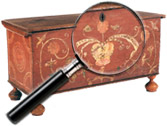|
|
William Howard Yorke (British, 1847 to 1921)
William Howard Yorke and his father William G. Yorke settled in Liverpool, England, about 1855. They were both marine artists. While William G. Yorke departed for New York, his son continued in to work in England. William Howard Yorke’s paintings have a distinctive use of bow and stern reflections.
Information courtesy of Skinner Inc., November 2009.
Adolph Robert Shulz (American/Indiana, 1869 to 1963)
Adolph Shulz is considered the “founding father” of Indiana’s Brown County Artist Colony. Originally from Wisconsin, Shulz began sketching at an early age and studied at the Art Institute of Chicago and the Art Students’ League in New York. His beautiful landscapes, in which the influence of his teacher, William Merritt Chase, can be seen, include the atmospheric effects of the Impressionist movement, but beautifully combine these [...] Click here to continue reading.
Ray Swanson (American, 1937 to 2004)
Primarily known for his sensitive portrayal of the native people of the American Southwest, Ray Swanson spent his artistic career in far-ranging travels to depict everyday scenes in an extraordinary manner. He held a deep fascination for the many ways in which people from different cultures shared common concerns.
Swanson grew up on a farm in South Dakota and developed an appreciation and respect for hardworking people who [...] Click here to continue reading.
John Neagle (American, 1796 to 1865)
John Neagle became one of the prominent and highly recognized portrait artists working in Philadelphia in the early nineteenth century. After studying and apprenticing with several artists, Neagle studied with the famed American portrait artist Thomas Sully, who influenced his style and use of color. Early in his career, Neagle made a painting trip to the South, and traveled to Kentucky in 1818 and then to New Orleans [...] Click here to continue reading.
Richard & Rosemarie Machmer Provenance
The following remembrances were publishing the Pook and Pook auction catalogue for this sale, held on October 24 and 25, 2008. For coverage of this sale, please see the account in Maine Antique Digest, published in January of 2009, available at http://www.maineantiquedigest.com/stories/index.html?id=1014.
About thirty-five years ago, I traveled around two hours to an evening country auction in Schnecksville, Pennsylvania. As I walked into the auction house, facing me was [...] Click here to continue reading.
Associated American Artists
In 1934, Reeves Lewenthal founded Associated American Artists. Lewenthal contacted many prominent American artists with the notion of publishing their prints in editions of 250 impressions to be offered to the public. Thomas Hart Benton, Will Barnet, Rockwell kent and Grant Wood are only a few of the important artists who accepted this offer. The first gallery was located at 420 Madison Avenue in New York.
Among the initial group of [...] Click here to continue reading.
The Philadelphia Ten
The Philadelphia Ten, also known as The Ten, was a group of female artists from the United States who exhibited together from 1917 to 1945. The group exhibited annually in Philadelphia and later had traveling exhibitions at other museums throughout the East Coast and the Midwest.
All of the members of the Philadelphia Ten attended art school in Philadelphia. The group’s first show was held at the Art Club of Philadelphia [...] Click here to continue reading.
Crazy for Tea
We’ve all seen the movies depicting English life in the 19th and early 20th centuries where a charming hostess calls on Flora, the parlor maid, to lay the tea for company. Flora soon reappears with a gleaming tea service and a plate of crumbly biscuits and sandwiches, and then retreats leaving the guests sipping and chatting. This English, and later the American, infatuation with tea may be easier to understand with [...] Click here to continue reading.
The Ephrata Cloister or Ephrata Community
The Ephrata Cloister or Community was a religious community established in 1732 by Johann Conrad Beissel at Ephrata, in what is now Lancaster County, Pennsylvania.
The community was descended from the pietistic Schwarzenau Brethren movement of Alexander Mack of Schwarzenau in Germany. The first schism from the general body occurred in 1728 – the Seventh Day Dunkers, whose distinctive principle was that the seventh day was the [...] Click here to continue reading.
John Edward Borein, (1872 to 1945)
Edward Borein was the oldest of five children of the deputy sheriff of San Leandro, a town along one of the California cattle trails.In 1893 Borein started working up and down the California coast as a ranch hand. He became proficient at roping and riding and seemed to have no regrets about this harsh lifestyle.
His first admirers were his cowhand acquaintances that in 1896 strongly encouraged [...] Click here to continue reading.
|
Recent Articles
- Charles Alfred Meurer – American Artist & Tromp L’Oeil Artist
- Sendak, Maurice – American Artist & Writer
- Godie, Lee – American Artist
- Davis, Vestie – American Artist
- Bartlett, Morton – American Artist
- Mackintosh, Dwight – American Artist
- Evans, Minnie Jones – African-American Artist
- Mumma, Ed (Mr. Eddy) – American Artist
- Nice, Don – American Artist
- Savitsky, John (Jack) – American Artist
- Gordon, Harold Theodore (Ted) – American Artist
- Dial, Thornton – African-American Artist
- Doyle Sam – American Artist
- Johnson, Lester Frederick – American Artist
- Finster, Howard – American Artist
|
|
